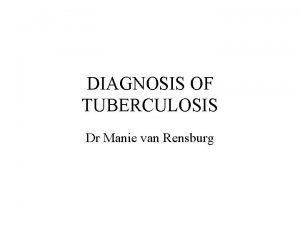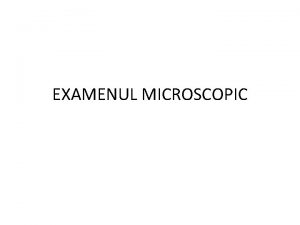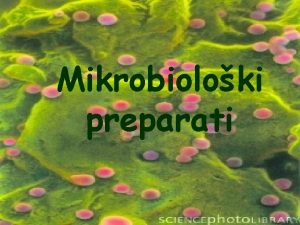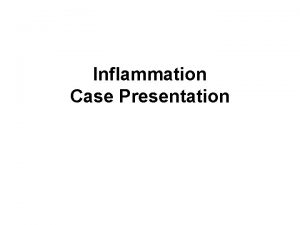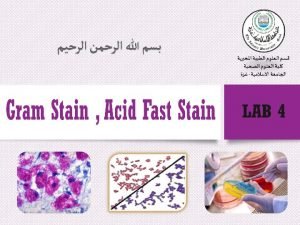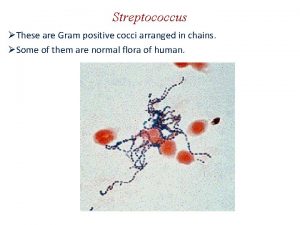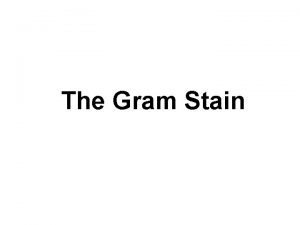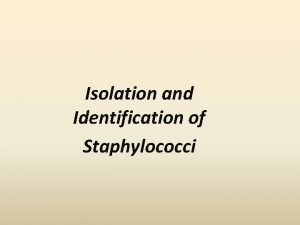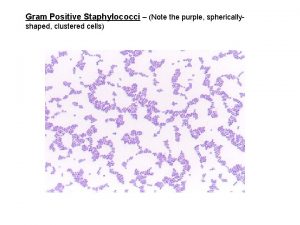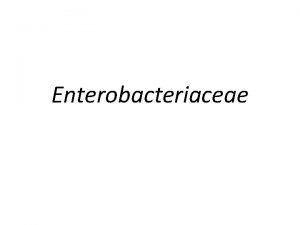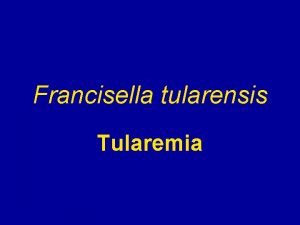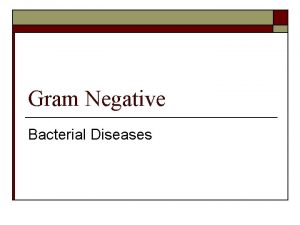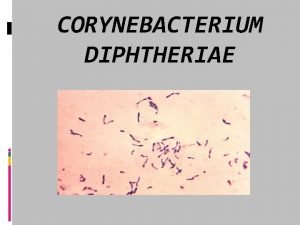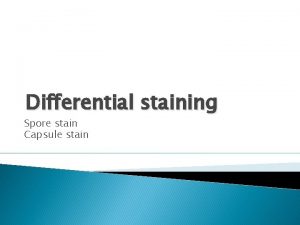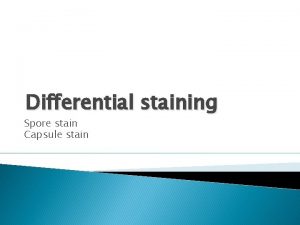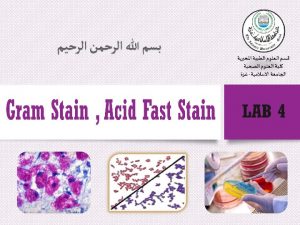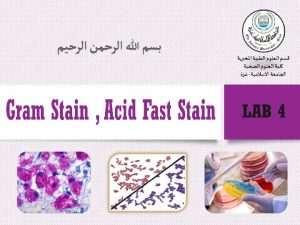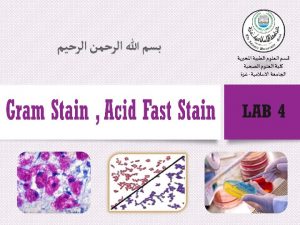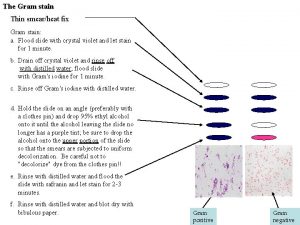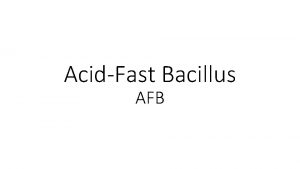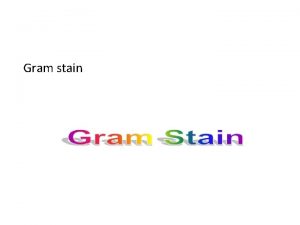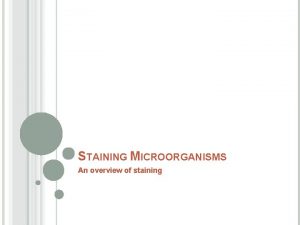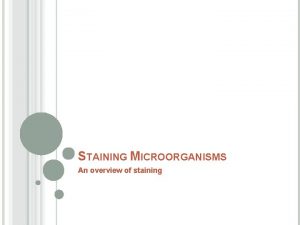Differential staining Gram stain Ziehl Neelsen stain Differential



















- Slides: 19

Differential staining Gram stain Ziehl Neelsen stain

Differential Stain � Requires reagents. the use of at least 3 chemical 1. Primary Stain: stain all the cells. 2. Decolorizing agent: may or may not remove the primary stain from the entire the cell or only from certain cell structure.

3. Counter stain: It will stain the washed out areas only, if the primary stain is not washed out the counter stain can’t be absorbed(the cell or it’s components will hold the primary stain)

Gram stain � The most important differential stain used in bacteriology. � Demonstrates 2 or more items( shape and color). � One of the first steps of identification and differentiation of bacterial species.

Gram stain � It divides bacterial cell into 2 major groups: 1. Gram +ve organisms: are organisms that resist decolorizing and retain the crystal violet iodine complex, They appear Purple. 2. Gram –ve organisms: are organisms that give up the complex and are decolorized thus accept the counter stain, They appear RED

� Reagents used: 1. Primary stain: crystal violet. 2. Mordant: iodine. 3. Decolorizer: alcohol-acetone. 4. Counter stain: safranin.


Gram stain � There are many theories to explain the differences but none is completely satisfactory � The most valid theory correlates the Gram reaction with differential permeability of cell � Gram –ve cells have more lipid content and thinner cell wall than Gram +ve cells � Lipids are soluble in decolorizer (acetone) � Pore size of cell wall increases by removal of lipid. This leads to removal of crystal violet-iodine complex. Thus counter stain enters and stains cell

Gram stain � Factors affecting Gram reaction: 1. Improper heat fixing of the smear. 2. Cell density (thick smear may not decolorize as rapidly). 3. Concentration and freshness of reagents. 4. length and accuracy of washing. 5. Nature, concentration and duration of decolorizer. 6. Age of bacterial culture.

Gram stain steps 1. Apply Crystal violet for 1 minute 2. Wash with D. water 3. Apply Iodine for 1 minute 4. Wash with D. water 5. Decolorize with Acetone for 7 seconds 6. Wash with D. water 7. Apply Safranin for 1 minute 8. Wash with D. water

Gram positive rods

Gram +ve cocci

Gram –ve organisms

Gram mixture Gram +ve and Gram –ve organisms

Ziehl Neelsen Technique ZN Acid Alcohol Fast stain � Used to demonstrate acid fastness of bacteria especially species belonging to genus “Mycobacterium”. � The cell wall of these bacteria contain a wax- like lipid called mycolic acid, this makes the cell wall very impermeable and will not stain with commonly used stains.

AAFB))Acid Alcohol Fast Bacilli � In this technique AAFB will retain the primary stain even after washing with the strong acid alcohol decolorizer � Reagents 1 - Primary stain : Carbol fuchsin 2 - Decolorizer: 3% acid Alcohol 3 - counter stain: Methylene blue

AAFB steps 1. 2. 3. 4. 5. 6. 7. Apply Carbol fuchsin for 10 minutes Heat the slide by passing a flame under the slide Wash with water Apply acid alcohol for 3 -5 minutes Wash with water Counter stain with methylene blue for 1 min Wash with water

AAFB � AAFB organisms retain primary stain and are not affected by strong acid alcohol decolorizer so the color will be red � Other organisms will stain blue � Heat was applied to increase the uptake of the primary stain by bacterial cell wall of AAFB � A strong decolorizer Acid Alcohol is used � Timing of staining is extended

AAFB
 Ziehl neelsen stain
Ziehl neelsen stain Examinarea microscopica a bacteriilor
Examinarea microscopica a bacteriilor Nativni preparati
Nativni preparati Ziehl neelsen
Ziehl neelsen Coloratia ziehl neelsen
Coloratia ziehl neelsen Gram stain vs acid fast stain
Gram stain vs acid fast stain Flow chart of gram staining procedure
Flow chart of gram staining procedure Gram staining procedure in flowchart '
Gram staining procedure in flowchart ' Mannitol salt agar staphylococcus epidermidis
Mannitol salt agar staphylococcus epidermidis Casein hydrolysis test results
Casein hydrolysis test results Serratia marcescens gram stain
Serratia marcescens gram stain Gram stain
Gram stain Tularemia gram stain
Tularemia gram stain Ooo
Ooo Gram stain mix
Gram stain mix Gram stain techniques
Gram stain techniques Diphtheria stain
Diphtheria stain Gram stain procedure
Gram stain procedure Cryptococcus neoformans india ink
Cryptococcus neoformans india ink Optochin test
Optochin test
